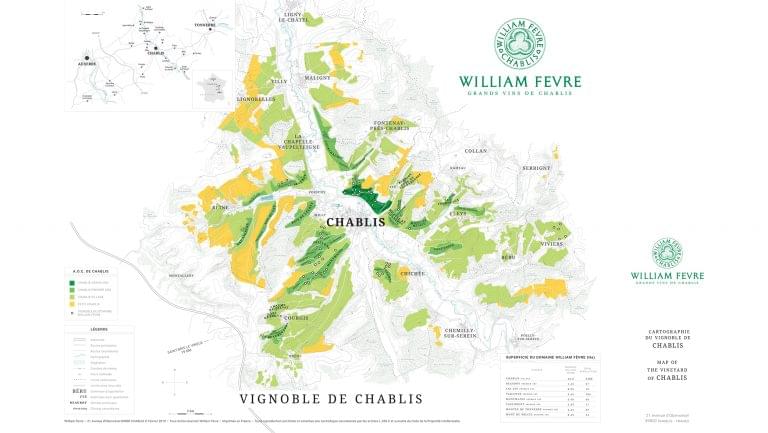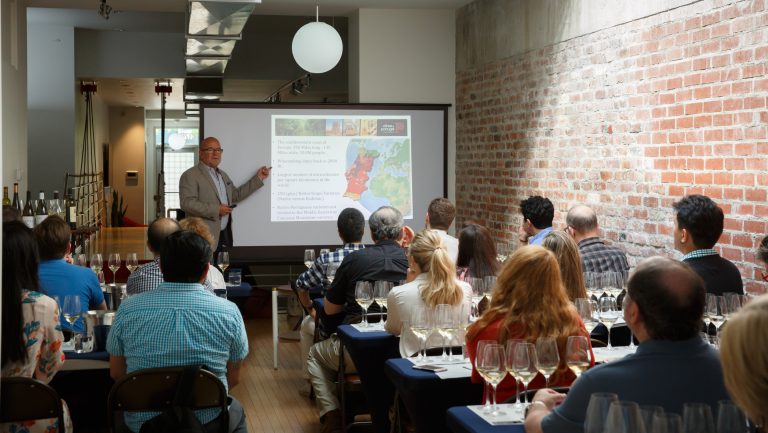This advertising content was produced in collaboration with our partner, William Fèvre.
If there exists such a thing as a silver lining during the throes of a pandemic, it transpired in Chablis in 2020. Despite the myriad of challenges the wine industry faced that year, from labor shortages to export woes to shuttered tasting rooms, William Fèvre not only survived but thrived. Extremely favorable growing conditions offset a global health crisis, and the restrictions required to mitigate COVID-19 actually evolved into useful efficiencies for future harvests. In short, William Fèvre was able to produce a perfect vintage during the most imperfect of circumstances.
“The quality of the juice in 2020 was very pure, very precise,” says cellar master Didier Séguier. “The vintage has the perfect expression of terroir.” Séguier, who was born in Cognac, joined the winery in 1998. With more than 37 acres, William Fèvre holds the largest amount of Grands Crus in Chablis, including Les Clos, the largest and considered to be the best of the seven Grand Crus.
Séguier recalls the hallmarks of that growing season: a mild, wet winter with higher-than-average temperatures, followed by a mild, dry spring and a historically early bud break in mid-March—two to three weeks earlier than normal. Early flowering was followed by a dry and hot summer that led to rapid ripening; things cooled a bit in August, when rain matured and improved the quality of the grapes. Harvest began August 25, 2020, one of the earliest dates since France’s historical heat wave in 2003. The cumulative result created high-quality grapes free from disease or botrytis, with concentrated fruit and lower yields due to the effect of pre-harvest winds.

Don’t miss the latest drinks industry news and insights. Sign up for our award-winning newsletters and get insider intel, resources, and trends delivered to your inbox every week.
But while growing perfect fruit might have been effortless in 2020, getting it off the vine and into the cellar proved to be anything but. William Fèvre is the region’s largest producer to harvest entirely by hand—a process Séguier believes is necessary to fully express terroir in the premiers and Grands Crus. Yet this wasn’t easy during the early days of the pandemic when travel was tricky, especially since their vineyard team of 150, which hails from Chablis and Bulgaria, was transported in buses with every other seat empty to allow for social distancing.
Modern windows for picking in Chablis are very short—one to two days per plot, with eight to ten days maximum for the entire harvest—creating additional logistical challenges for the vineyard crew. “The harvest date is the most important factor these days,” Séguier explains. “If you harvest too late, you don’t make Chablis, you make fat and heavy Chardonnay.” To that end, five members of the team completed maturity control in the days and weeks leading up to picking, analyzing sugar and acidity levels by tasting the grapes and seeds—no small feat considering William Fèvre owns 130 different plots.

Maintaining safe distancing once the grapes arrived at the winery actually forced the winery to think about how to better organize workers and direct their movements and workflow—a positive effect that led to increased structure and efficiency that they adopted as a permanent practice. Once the fruit is in the cellar, Séguier subscribes to a philosophy of minimal intervention; grapes undergo a few hours of pneumatic pressing, and a two-day fermentation. The 2020 vintage was bottled in March 2022 after 18 months of aging on the lees in used barrels, which increased freshness, complexity, and aging potential.
Séguier describes the 2020 vintage as elegant, with beautiful floral notes and good length, tremendous precision in its expression of terroir, and natural richness balanced by maturation. Their estate has one of the most homogenous terroirs in Chablis, with white, dense, and deep clay soils atop a limestone bed, lending a level of power, intensity, and spice. They also own six hectares in Bougros, known for richer soils and rounder wines.
Of course, no description of terroir in Chablis would be complete without a mention of Kimmeridgian soil. This mixture of limestone and clay, which formed millions of years ago from the marine fossils that formed at the bottom of the sea that covered the region, is why the wine picks up its signature minerality. “Chablis is a unique place in the world where you can find Chardonnay and Kimmeridgian together,” Séguier notes. “When you drink Chablis, you drink Kimmeridgian.” While maturity of the grapes is also important for imparting minerality, paramount is this iconic soil composition.
Also inextricably linked to the quality and character of William Fèvre’s wines is their commitment to sustainability. As a pioneer of organic and biodynamic practices in the region, theirs was the first domaine in Chablis to receive the HVE3 (High Environmental Value) certification in 2015, and 2020 marked the twentieth vintage since Séguier began to work organically. All vineyards undergo organic practices; 2023 will be the first certified organic vintage for premiers and Grands Crus, with the rest following suit in 2026.
They also launched biodynamic practices in 2010, including 500P (prepared horn manure) and 501 (horn silica). Although there are no current plans to officially convert, Séguier definitely sees benefits in the philosophy. “You increase the life and the good bacteria in the soil,” he says. “This adds minerality and precision in the wines, with better purity and energy.”
Other sustainability measures include swapping tractors for horses to till the soil, using animals for grazing, and installing birdhouses, bat boxes, and beehives. Most noteworthy is the use of an electric wire and cable system as an alternative to petrol for frost-prevention. Today it’s used to protect two hectares, with plans to expand, though the steep price tag of €80,000 to €100,000 is decidedly an obstacle.

Fortunately, climate change is mitigating spring frosts and other issues faced by regions whose vineyards have traditionally struggled to ripen—a positive effect that makes Séguier understandably conflicted. “Climate change is bad for the world, but for the moment, it gives us better regularity in maturity compared to forty or fifty years ago.” The main challenge in Chablis is to retain grapes’ acidity, so once again, harvest dates are incredibly important, especially in warm vintages like 2020. “We can still have a good vintage with a warm year; 2020 shows very well and is very classic,” he says.
Those warmer conditions translate to more approachable wine that’s drinkable sooner, with a pleasingly angular yet less aggressive acidity. Séguier says that in the next five to six years, the 2020 wines will show primary fruit aromas of Chardonnay, with the terroir-driven aromas and minerality developing around year seven and increasing every year afterwards. Stored in proper conditions, William Fèvre Chablis will easily mature for two decades. Luckily, since the 2020 vintage is just arriving to the U.S., always impatient-to-uncork American consumers get a little extra boost on that bottle aging.

Dispatch
Sign up for our award-winning newsletter
Don’t miss the latest drinks industry news and insights—delivered to your inbox every week.









